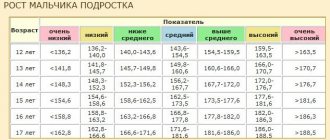Teenagers' body types can be very different from their peers. According to research, girls experience a growth spurt between the ages of 10 and 12. Boys begin to grow sharply from 13 to 16 years old. Normal weight at 14 years old can be determined by the average typical values, which are considered normal for this age period. If the teenager is within the limits, then there is nothing to worry about.
Body types. Norms of weight and height for adolescent boys and girls with different body types
The physique is formed in the process of human growth and development. The final result directly depends on a combination of endocrinological and exogenous factors. With age, constitutional differences become more noticeable. The relationship between the rate of maturation and physique is characterized by clear sex characteristics.
Accelerated puberty is most often observed in girls of the muscular and digestive types. But teenagers of the asthenoid type may lag behind their peers. Whether a child belongs to a certain body type is a diagnostic test to determine the rate of development.
Asthenic
The Pigne index, which takes into account the weight, height, and chest circumference of the child, helps to correctly determine the type of physique. From the figure that indicates height in cm, the known volume of the chest is subtracted, as well as body weight in kg. If the final result exceeds 30, then we are talking about an asthenic physique.
Asthenics (ectomorphs) are thin, thin-boned people. This feature is well manifested in infancy, as the child is underweight, eats poorly and grows too slowly.
A sudden growth spurt occurs in adolescence, which is why many adult asthenics are over 177 cm tall. But there are teenagers who are thin and short in stature.
The following characteristics are characteristic of an asthenic physique:
- Narrow shoulders.
- Disproportionately elongated arms and legs.
- Pale skin, dark circles under the eyes.
- Insufficient muscle volume.
- Long neck.
The optimal height-to-weight ratio for adolescents with an asthenic physique is shown in the table:
| Height (cm) | Boys weight (kg) | Girls weight (kg) |
| 148 | 44-46 | 42-44 |
| 152 | 47-50 | 43-47 |
| 158 | 51-54 | 46-50 |
| 162 | 53-56 | 48-52 |
| 168 | 56-60 | 52-56 |
| 172 | 62-63 | 54-58 |
| 178 | 63-68 | 59-63 |
Normosthenic
The normal height and weight for teenagers (a table with data allows parents to monitor the development of their child) depends on the type of physique. The normosthenic appearance is distinguished by ideal ratios of muscle tissue and, as well as proportional development of all parts of the body.
This figure is characterized by a sporty appearance, which even in the absence of sports looks fit. In medicine, normosthenics are also called mesomorphs.
A normosthenic body type presupposes a slim person, but even if there is an excess amount of fat deposits, with the help of a properly formulated diet and regular physical activity, you can quickly get rid of extra kg. Among the features of this figure are broad shoulders, average height and narrow hips.
Teenagers with a normosthenic physique are distinguished by their endurance, energy, determination and perseverance.
The normal weight depends on the height of the teenager:
| Height (cm) | Boys weight (kg) | Girls weight (kg) |
| 151 | 48-52 | 45-50 |
| 154 | 51-57 | 46-52 |
| 158 | 53-58 | 48-54 |
| 162 | 55-61 | 51-56 |
| 168 | 59-65 | 54-60 |
| 172 | 62-68 | 57-64 |
| 178 | 66-72 | 61-68 |
Hypersthenic
Teenagers with this body type are most susceptible to gaining extra pounds. Hypersthenics are characterized by certain skeletal features, such as a voluminous chest and a wide waist. The limbs are slightly shortened.
In many hypersthenics, height does not reach the average level, and the excessively high position of the diaphragm makes the neck visually much shorter, which creates the effect of a heavy figure. The silhouette has rounded outlines and smooth lines.
Already in adolescence, hypersthenics can experience a rounded abdomen. The facial bones are wide, with neat contours. At an early age, men may show a tendency towards baldness, but at the same time there is increased growth of facial hair.
Hypersthenics tend to slow down metabolic processes, which causes them to quickly accumulate excess weight, which is difficult to get rid of.
A more detailed relationship between height and weight of adolescents is shown in the table:
| Height (cm) | Boys weight (kg) | Girls weight (kg) |
| 151 | 52-58 | 48-55 |
| 156 | 56-62 | 51-58 |
| 162 | 59-66 | 54-62 |
| 166 | 61-69 | 58-66 |
| 169 | 63-72 | 59-67 |
| 172 | 66-74 | 61-69 |
| 178 | 70-79 | 65-74 |
What should you not eat?
Despite the need for a quick gain of fat and muscle tissue, you should not abuse the following foods:
- chocolate butter;
- canned fish;
- sausages and sausages;
- canned pate;
- lean meat (rabbit, turkey, chicken);
- confectionery products that contain palm oil or other trans fats.
It is not recommended to include in the daily menu products that contain preservatives, stabilizers, emulsifiers, food coloring, as well as other food chemicals.
Rules for conducting anthropometric measurements
Anthropometry must be carried out using special devices: a stadiometer, scales, and a measuring tape. All planned measurements are carried out in the morning or 4 hours after eating.
The teenager should wear light clothes made of knitted fabric. If the procedure has to be performed in the evening, then the child needs at least 20 minutes. lie down on the couch to relax your spine.
It is permissible to measure height only using a special stadiometer. The teenager carefully stands on the small platform of the device, turning his back to a special stand. The back needs to be leveled so that the interscapular surface of the back and buttocks touch the structure. A small bar is lowered towards the head.
It is recommended to take all necessary measurements before lunch, since in the late afternoon each person’s height decreases by 1.5 cm. This is directly related to the fatigue accumulated over the past day and a decrease in overall muscle tone.
Body weight is determined on floor or lever scales, on which the teenager must stand motionless. When weighing, the permissible error can be a maximum of +/-45 g. Weight is less stable than height, since it depends on many indicators. Daily weights vary from 900 g to 2 kg.
How to quickly gain weight for a teenager?
At home, you can really quickly increase your child’s weight by following these recommendations:
- Increase the amount of foods rich in fiber, carbohydrates and proteins in your child’s diet (bread, pasta, legumes, nuts, poultry, fish, meat). Also include a sufficient amount of fresh berries, fruits and vegetables in your diet.
- You need to eat more often . Five meals throughout the day is the most optimal option for a teenager.
- Make sure that your child does not eat too much fried and fatty foods , as they take a long time to digest and create the impression of fullness, which leads to a decrease in appetite. It is advisable to avoid eating fast food.
- Sign your child up to the gym. There, with the help of an instructor, he will be able to build muscle mass. A competent instructor will select a suitable set of exercises for your child, taking into account the characteristics of his body. You need to go to the gym so that muscle mass increases evenly and fat deposits do not appear in the most inappropriate places.
Calculation of averages
To understand whether a child’s data corresponds to age standards, it is necessary to take into account a set of anthropometric parameters. Natural physiological processes occurring in the body of every person are of great importance. A growth spurt may well be preceded by a sharp weight gain.
If you look at the tables, you will notice that the height norm is met, but the weight exceeds the limits. There is no need to worry about this, since after 3 months the situation will stabilize.
If a child looks too thin at his height, but no chronic pathologies have been detected and he has a good appetite, then by the end of puberty the proportions will normalize.
When measuring, bone mass should be taken into account. In medicine there is such a term as “heavy bone”. This phenomenon is more often recorded among boys who are overweight, but there are no visual signs of excess weight.
It is forbidden to confuse body weight with volume. Sometimes overweight children can weigh much less than their peers who play sports hard, since fat cells are lighter than muscles.
The weight of an athlete with muscle mass will go beyond the data presented in the table, and a child with excess fat deposits will fall into the category with those indicators that are within the normal range.
Example of a daily diet
A quick gain of additional body weight requires proper nutrition and preparation of a preliminary menu.
An example of a daily diet for an adult should look like this:
- breakfast - soup with pork, buckwheat porridge with beef cutlet, sweet tea with a bun;
- snack - milk with honey and white loaf;
- lunch - borscht with veal, mashed potatoes with chops, salad with tomatoes, dressed with unrefined sunflower oil, white bread, coffee with a roll;
- snack - protein bar;
- dinner - lamb shurpa, pasta with pork meatballs, sweet tea with a bun and jam;
- 1 hour before bedtime, a glass of warm milk with honey.
Enhanced nutrition for a child who is underweight consists of the following daily menu items:
- cream soup with pork, which together with vegetables is pureed using a blender, white bread, sweet tea with cookies;
- snack tuna sandwich, fruit jelly;
- lunch - barley porridge with beef goulash, vegetable salad, milk with honey and white loaf;
- snack - cookies with cherry juice, banana;
- dinner - macaroni and cheese, pork pate with white bread, fruit jelly;
- in 30 min. before going to bed, if the child does not refuse, you can give him a glass of warm milk with honey or cookies.
Weight estimation using body mass index
BMI is a parameter that maximally describes the relationship between weight and height (weight in kg divided by twice the length in m). It is important to understand that BMI standards for adolescents differ significantly from those for adults. In the early years, the optimal body mass index varies from 13 to 17 units, and in adolescence it increases to 18-20.
If the child’s weight is 1 kg below the minimum, then there is no need to adjust it. For more significant weight loss, examination by a pediatrician and nutritional correction are indicated.
In boys and young men
The norm of height and weight in adolescents (a table with anthropometric data allows you to monitor the child’s development) is an important indicator that is closely monitored not only by pediatricians, but also by parents.
The proportionality of development can be determined using the BMI formula. To correctly calculate BMI, you need to divide your initial body weight by your height, which is first squared. For example, height 151 cm is 1.51 m, weight is 49 kg. Calculation: 49/(1.51*1.51)=21.4.
The weight assessment of boys and young men by body mass index is shown in detail in the table:
| Age (years) | Norm | Slight underweight | Seriously underweight | Excess weight | Obesity |
| Body mass index kg/m² | |||||
| 12-13 | 17.8 | 15.3 | 14.5 | 22.4 | 24.3 |
| 14-15 | 19.2 | 16.3 | 15.7 | 23.9 | 26.0 |
| 16-17 | 20.5 | 17.8 | 16.8 | 25.3 | 27.5 |
In girls and girls
Anthropometric indicators for people of all ages are presented by WHO specialists in the form of tables. In addition to the average, they contain separate columns with upward/downward deviations. Parents of teenage girls and girls need to pay particular attention to these indicators, since their bodies are just developing.
You can estimate your weight using your body mass index using the table:
| Age (years) | Norm | Slight underweight | Seriously underweight | Excess weight | Obesity |
| Body mass index kg/m² | |||||
| 12-13 | 18.0 | 15.4 | 14.6 | 21.7 | 25.2 |
| 14-15 | 19.1 | 16.3 | 15.5 | 23.2 | 27.1 |
| 16-17 | 20.5 | 17.4 | 16.3 | 24.6 | 28.9 |
How to quickly gain 5 kg for a thin girl, woman, child?
In order to gain about 5 kg within 7 days, you need to focus exclusively on carbohydrate foods , as well as foods containing fats of plant and animal origin. The daily menu should include porridge made from barley, wheat, corn, oatmeal, seasoned with pork, beef or lamb goulash.
The diet includes pasta, sweet tea with rolls, honey, condensed milk, and baked goods. In the intervals between taking main meals, it is necessary to provide the body with plenty of drink so that everything eaten is fully absorbed. In this case, a child, girl or adult woman should lead a sedentary lifestyle.
Growth Estimate
The normal height and weight of a teenager is an important indicator, which is why pediatricians recommend regularly checking changes in the child’s anthropometric data. A special table helps to compare official indicators with the collected information, but a correct analysis of the final figures is important.
There are several options for assessing growth:
- Very low. This parameter indicates serious delays in physical development, which is why the teenager should immediately undergo a full examination.
- Short. The indicator may indicate a developmental delay. Low rates are often recorded among children who were born prematurely.
- Below the average. This is an insignificant shortfall in height, which should not cause panic among parents.
- Average. A generally accepted standard that is common to many teenagers.
- Above average . Deviations along the hereditary line are not excluded.
- High.
- Very tall. This indicator indicates that the teenager has endocrine disorders, which is why it is better not to postpone a visit to the doctor.
To objectively assess growth, it is not recommended to rely solely on tabular data. It is necessary to take into account hereditary factors, characteristics of the puberty period, as well as the lifestyle of a teenager, since these factors play a key role in the formation of a growing organism.
Weight standards
The tables present weight norms for adolescents of different genders at 14 years of age.
For boys:
| Age | Very low | Short | Below the average | Average | Above average | High | Very tall |
| 14 years | 34,3 | 38 | 42,8 | 48,8 | 56,6 | 63,4 | 73,2 |
What is the normal weight for girls at 14 years old:
| Age | Very low | Short | Below the average | Average | Above average | High | Very tall |
| 14 years | 37,6 | 43,8 | 48,2 | 52,8 | 58 | 64 | 72,2 |
It is important to understand that the percentage of fat at the same weight can vary dramatically. Those who constantly play sports and have developed muscles may have more weight than a chubby classmate. This doesn't mean you have to go on a diet. There was simply more muscle mass; this may not be visible outwardly.
The same goes for weight if you are tall. Often in adolescents who have grown sharply in a short period of time, the muscles do not have time to increase, but only stretch out following the skeleton. Good nutrition, exercise and healthy sleep will improve the situation.
Periods of accelerated, intensive growth of a teenager
During puberty, adolescents may experience a significant increase in body weight and length. In girls, a real jump in parameters can occur at the age of 12, since the increase in height can reach 8 cm. But after 1 year, the rate of development decreases.
Accelerated maturation in boys occurs at 14-15 years of age. In the period from 12 to 14 years, girls are significantly superior to boys, who catch up with their classmates in all respects only by the age of 16.
The period of intensive maturation is characterized by certain characteristics:
- Legs and arms may be disproportionately thin and long.
- The figure looks awkward in appearance.
- There is clumsiness in the movements.
- The physique is thin.
Uniform physiological development is characterized by a gradual increase in figure parameters. In other situations, accelerated adolescent growth is accompanied by a sudden increase in height and weight in just a few months.
Mass gain pills
To quickly recover, you can take the following drugs, which are sold in retail pharmacy chains:
- Riboxin — improves energy metabolism, stabilizing the functioning of the heart and liver tissue, take 1 tablet 2-3 times a day for 1-3 months. (indicated for use only in adults);
- Glutamic acid - the drug improves nitrogen metabolism, promotes better absorption of proteins and muscle mass gain, taken 1 g 2-3 times a day for 15 minutes. before meals (course of therapy from 1 to 12 months), not used for children under 3 years of age;
- Methionine is an amino acid that takes part in metabolic processes in the body, improves the absorption of nutrients consumed with food, taken 500 mg 2-3 times a day for 1 month.
Medicines for weight gain should only be prescribed by your doctor after a preliminary examination.
Centile tables of height and weight ratio
The norm of height and weight for adolescents (a table with data is used in pediatrics to monitor the development of children) is taken into account from the first days of a child’s life. The centile method of assessing physical condition and development is based on comparing the child’s indicators with average parameters that were derived based on mass assessments of groups of children of the same age.
Centile tables indicate the ratio of information on body weight and height, chest and head circumference. Based on averaged data, pediatricians can build a development chart, graphically displaying changes in anthropometric parameters as they grow older.
The data are grouped by gender, since the characteristics of the indicators depend on this factor.
After taking all the necessary measurements and comparing them with the indicators of the centile table, the doctor can evaluate the development of the teenager, where the maximum score is 8.
The centile tables adopted by pediatricians were approved at the legislative level after research by the World Health Organization based on anthropometric data of healthy children from different parts of the world.
Main body types
The correspondence between girls’ height and weight is influenced by their constitution; in total, three types of structure are distinguished:
- fragile - asthenic;
- normal - normosthenic;
- dense - hypersthenic.
You may be interested in: How to lose minus 10 kg in a week with a watermelon diet
To determine your body type you need to:
- clasp your left hand with the thumb and index finger of your right hand;
- if your fingers wrap around it easily, you are asthenic;
- fingers almost touching - normosthenic;
- this is impossible to do - hypersthenic.
Determination is also possible by external signs:
- fragile girls have thin bones and necks, legs longer than the body, poorly developed muscles, and no folds of fat;
- those with a normal and average build are proportionately developed and slim;
- dense women have wide and heavy bones, are wide in the pelvis and chest, they have short arms and legs, a stately and strong appearance.
Three types of human body structure, which differ in the proportions of bone structure and muscle mass
Asthenic
The amount of body weight of women of this somatotype greatly depends on a properly selected diet. Despite their thin build, they quickly gain weight, which is not compatible with weak muscles and thin bones.
The benefits of good metabolism, activity and energy play into their hands, allowing them to stay slim for a long time.
Normosthenic
Owners of this type are the luckiest. They have a beautiful, proportionally built figure. All body sizes and parameters are perfectly correlated with each other. The average metabolic rate serves as a reliable insurance against unexpected kilograms.
Hypersthenic
Representatives of the hypersthenic type are quite large in themselves. At the same time, they have a small amount of fat with decent muscle mass. As a rule, they are short, have wide bones and short legs.
How to use
To be able to find out whether the child is developing in accordance with current standards, you need to select a centile table that corresponds to the age of the teenager. Opposite each age, indicators of body weight, height, chest and head circumference are recorded, which must be compared with the parameters of the child.
Depending on what centile interval the desired parameter is in and how far/close it is from the average value, one can judge the proportionality of the adolescent’s development.
How to recover from stress?
To restore body weight lost as a result of a stressful situation, it is necessary to stabilize the digestive system. Every morning should begin with the consumption of natural fermented milk products. These are yogurt with live lactobacilli, kefir, fermented baked milk, yogurt. After 30 min. After starting the digestive system, you can start the main breakfast.
All daily meals should contain high levels of carbohydrates and animal fats. The consumption of chocolate, buns and pasta is also required. At the same time, it is necessary to protect the body from further stress.
Quetelet's formula
In this case, it is impossible to obtain ultra-accurate results. Body mass index is an important indicator of common problems such as obesity and anorexia.
You can calculate the ratio of height and weight for a teenager using Quetelet’s formula:
- Body mass index = B/(P*P).
- For example, height is 1.71 m and weight is 52 kg, then body mass index = 17.9.
- If the body mass index with such height is below 17.5, then we are talking about anorexia, and if it is in the range from 17.5 to 18.5, then this is underweight. Indicators of 19-23 are the norm for 17-18 years old.
The Quetelet index allows you to assess the deviation from the norm of a teenager’s body weight depending on his height, weight and age.
Much depends on the body type that is given by nature. But it is always possible to correct external data with the help of proper nutrition and physical activity.
How to increase weight with a fast metabolism?
With a fast metabolism, it is necessary to rely on foods that take a long time to digest in the gastrointestinal tract, contain a high percentage of carbohydrates and have excellent energy value. In this case, these are buckwheat, pearl barley, and rice.
The menu should also include peas, beans, lentils, pig meat, beef, lamb, and bacon. On the basis of porridges, gravies and meat dressings with animal fats are prepared. In between meals, you should have light snacks, eating a sandwich or a protein bar.
What can cause developmental disabilities?
The main percentage of existing developmental deviations is associated with disturbances in the functioning of the nervous system or a specific analyzer, due to which an atypical structure of the body arises. Negative changes in the functioning of certain organs and psychological systems cannot be ruled out.
Pediatricians identify several main reasons due to which deviations in the development of a child may occur:
- Congenital disorders. Anomalies in the development of internal organs, which are associated with drug addiction and alcoholism of parents, and unfavorable pregnancy.
- Hereditary disorders . Genetic pathologies manifested in metabolic disorders in brain tissue. Most often, certain forms of mental retardation, deafness, Down's disease, and blindness are inherited.
- Psychological disorders.
- Postnatal disorders . Encephalitis, meningitis, polio, vascular diseases of the brain, traumatic brain injury.
- Acquired anomalies.
Deviations in the development of a teenager may be associated with birth disorders, which may be accompanied by mechanical damage to the fetus, asphyxia, and intracranial hemorrhage.
Low weight: why is it bad and how does it threaten your health?
Girls who lead a sedentary lifestyle or have a hereditary predisposition to rapid weight gain are able to gain weight quickly. Excess weight negatively affects the functioning of the entire body, but pronounced thinness and a systematic deficiency of fat and muscle tissue also do not go away without leaving a trace.
Too little weight threatens the development of the following complications and health problems:
- disruption of the body's thermoregulation process;
- decreased immunity;
- tendency to nervous breakdowns and depression;
- disruptions in the digestive, genitourinary, and endocrine systems;
- absence of menstruation, or too short a period of menstruation, which is accompanied by scanty discharge;
- inability to conceive a child;
- risk of developing cholelithiasis and gout;
- tendency to frequent constipation;
- loss of elasticity and firmness of the skin.
Most girls suffering from excessive thinness have wrinkled and too dry skin. Metabolic processes in the body are disrupted, and fat-soluble vitamins A, E, D, which enter the body with food, are not fully absorbed due to lipid deficiency.
Problems of high growth of teenagers
In high school, a common situation is when one of the teenagers stands out among his peers for his great height.
The following factors can influence this phenomenon:
- Increased production of growth hormones.
- Acromegaly.
- Heredity. If a boy or girl has one of the parents who is tall, then this can be passed on to the child.
- Klinefelter's syndrome.
- Marfan's disease.
- Early maturation.
- Presence of excess fat mass.
If a teenager’s height is above average, then you need to contact an endocrinologist who will prescribe a comprehensive examination.
Growth statistics
If we talk about height, the average here will be 157.1 cm for a girl. A possible range of deviations from very low to very high is 143-168 cm. It is worth noting that at this age, according to statistics, girls are taller than their peers, boys, who on average reach 156.2 cm in height. Although for them the range of values can vary from 141.8-170.7 cm.
The problem of short stature
A real cause for concern for parents may be that their child is much shorter than his peers.
There are several reasons why a teenager’s height may not reach the norm:
- Presence of bad habits (drinking alcohol, drugs, smoking).
- Genetic predisposition.
- Lack of vitamins in the body of a teenager.
- The presence of serious pathologies.
Pediatricians recommend that parents monitor the normal height and weight of adolescents using special tables. If one of the child’s parameters does not correspond to the norm, then it will be possible to establish the true cause only after a comprehensive examination.
Author of the article: Dorogokup Daria
What happens to teenagers at the age of 13?
The 13th birthday is a transitional date when teenagers undergo enormous changes, grow up, fall in love, and change. Girls and boys go through the so-called puberty, becoming girls and boys. Everything changes: their appearance, emotional state, hobbies, inner world. Changes in the body and figure become obvious. And many are beginning to wonder how much girls should weigh at 13 years old. Does your height match your weight? Is development proceeding proportionally, are there any deviations? After all, everyone dreams of being a beauty, looking slim and attractive.
How to measure and at what age
Active growth of the intimate organ in boys begins from the moment of maturation, that is, from 12-13. From this moment on, doctors have age standards for lengths, which increase by an average of 1 cm every year. The average length of the penis at 15 years old is 6-7 cm (in a fully erect state, 12-16). At the age of fourteen, 5-6 cm (11-15 cm), at 13, approximately 5 cm (10-13 cm).
For the calculations to be correct, the organ must be measured correctly:
- The first measurement is carried out at rest. A measuring tape is better suited for this, rather than one with a larger percentage of errors.
- The penis needs to be fixed (without stretching!) parallel to the floor and the edge of the meter should be applied to its very root.
- The length corresponding to the end of the head is equal to the length of the penis in a quiet position.
- The procedure is repeated until a full and stable erection is achieved, while continuing to fix the penis in an even, parallel position to the floor.
If there are “unsatisfactory” results, repeated measurements should be taken, but not earlier than after 3-4 months. The procedure is carried out once every 6 months and preferably with a male parent.











